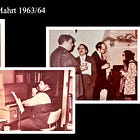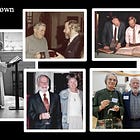Part III: "The Remarkable Sixty-Year Survival of Professor Mahrt's St. Ann Choir"
You can see William Mahrt after after he came back to Stanford as a professor in some of the photos above. According to Dr. Alison Altstatt, whose parents joined the choir in 1965, the two photos on the left were taken in the St. Ann Newman Center house in the mid-1970s.
In the top left photo, Mahrt is singing and leading a procession going through an arch into the dining room of Norris House (at the Stanford Newman Center) for Christmas dinner. Beside him is Mary Keirstead, who sang as a founding member of the choir, and who died in 2001. (Her obituary is here.)
Behind them holding a candle aloft is Marion Rubenstein, harpsichordist and organist, who sang with the choir beginning as a student at Palo Alto High School. In 1988, she played the organ for the choir when she was a Stanford graduate student in music. When I sang briefly with the choir in 2006-2007, Marion often directed the choir when Professor Mahrt was away.
In the photo of a group of people sitting on the floor, Mahrt is in the center. The blond woman is Susan Altstatt, Alison’s mother. I’ll talk about Susan’s contributions more later.
Alison wrote, “My parents John and Susan Altstatt were married in 1965 at St. Ann Chapel, at that time, home of the Stanford Newman Center. They joined the choir soon thereafter and my sisters and I were raised in this community.”
The year after the choir started William Pohl left Stanford for the University of Minnesota where he taught mathematics from September 1964 until his early death in 1988 at the age of 51, in the 25th year after the choir’s founding. Pohl remained a close friend of William Mahrt and John Altstatt (Alison’s father) until his death. Mahrt sang at two Requiem Masses for Pohl in Minnesota, and the St. Ann Choir sang a Mass for him at the St. Ann Chapel.
When William Pohl left Stanford in 1964, he turned the choir over to William Mahrt.
After Mahrt finished his Ph.D. in Musicology, in 1969, he also left Stanford for several interim positions, including acting as Visiting Assistant Professor of Music at Case Western Reserve University.
All the names of people who directed after Pohl’s departure are listed here.
1963-64 William Pohl
1964-66 William Marht
1966-67 Erich Schwandt
1967-69 William Marht
1969-71 Kari Windingstatt and Fr. Andrew Forster
1971-73 Beverly Simmons and Hermann Ebenhoech
1973-now William Mahrt
(spring and summer 1976, Beverly Simmons and Ron Sverdlove)
You can read the rest of Professor Mahrt’s account of the choir’s history including many more details about the other directors, the organ, and the choir’s organists after Pohl’s departure at Google Drive here.
From 1969-73, the choir had two directors at a time. From 1969-71, Kari Windingstatt, who had sung with William Pohl at Berkeley, led the polyphonic music. Fr. Andrew Forster, who had directed chant choirs at both the major and minor seminaries of the diocese, led the chant. From 1971-73, Beverly Simmons directed the polyphony, and Herman Ebenhoech directed the chant.
Miriam Palm, great friend of the choir, was in the audience for my talk, and she later sent me the photo on the right of William Mahrt. Palm sings with the Stanford Early Music Singers, a group that is also directed by Mahrt, and she sings with the St. Ann Choir for special events or when Bill is short-handed.
After Professor Mahrt returned to join the Stanford faculty in 1972, he resumed directing the choir the next year. He told me once that Susan Altstatt was instrumental in helping him regain his former role, since she asked the pastor to consider having Mahrt direct the choir again. And he has done so ever since, for almost 50 years straight.
Under his leadership, the choir expanded its repertoire. But he often states that the choir’s main accomplishment is that they continue to follow their original plan until this day. As I’ve remarked, he managed to do so even when that kind of music was almost completely out of favor.
In St. Paul, Minnesota, Professor Pohl became active in singing and leading at St. Agnes Church, which is famous in Church Music Association of American circles as the church where Fr. Robert Schuler founded a great music program that included many many orchestral Masses that were hardly ever heard sung after the Second Vatican Council.
I found this quote about Pohl in a post at Catholic Forum about Sacred Choral Music at Saint Agnes.
“In the early 1970s, Dr. William F. Pohl, a professor of mathematics at the University of Minnesota, sang the Gregorian chant, mostly solo, while developing a small schola of Chorale volunteers to assist him. Dr. Pohl guided the chant during the aftermath of the Second Vatican Council when all the liturgical books were being revised no small task, but as some may recall, he was no small man.
Because of Pohl’s size, those who wrote about him often mentioned he was big—in more ways than one. When I told Professor Mahrt this observation, he agreed, with a laugh. “Yes, he was Big, in more ways than one.”
Another article I found referred to Professor Pohl as a “large man whose size was somewhat imposing, and he was a great intellectual. . . . He started a Gregorian Chant choir at St. Agnes Church in St. Paul, Minnesota, . . . and sang in the Twin Cities Catholic Chorale.”
After the Mass of 1969 was mandated, while chant was replaced with hymns, and most Masses were offered in the vernacular, the local language, but in Palo Alto the St. Ann choir continued to sing the ordinary and the propers. In the beginning years, there was some experimentation with English chant, but the choir settled into singing the ordinary and proper in Latin Gregorian chant.
Bottom middle: William Pohl’s gravestone at Resurrection Cemetery, Mendota Heights, MN; Right: Minneapolis Star Tribune Obituary.
The above photos were taken by John Altstatt. Most of them show either William Mahrt, John Altstatt, or Susan Altstatt with various keyboards. One shows John Altstatt playing a lute. Another one shows a small group singing. I will continue trying to it IDed.
A note from Mahrt on the back of the left photo on the bottom row reads, “Chip Parmalee’s Pentagonal Virginal 15 LB.”







